
Vol. XIII, No. 1, January 2013
- Editor's corner
- The challenges of producing international entertainment projects: Our Vietnam experience
- The science of the queue
- Foundations Entertainment University goes to Vegas
- Feasibility and economics for entertainment projects in emerging economies
- Birthday University scholarships
- Location-based entertainment experiences go premium
- Entertainment spending in the local community by income
The challenges of producing international entertainment projects: Our Vietnam experience
Entertainment projects of all types, including bowling, family entertainment centers and theme parks, have a long tradition in the West. However, that is not the case in many parts of the world. In many countries with emerging economies some of the very first entertainment projects are just now being developed. This includes large parts of Asia, Africa and Eastern Europe.
Over the past 20 years our company has been fortunate to work in 32 countries throughout the world, often at the very beginning stage of the development of entertainment projects. That includes some of the first entertainment projects in Latin America, Africa and the Middle East. Working on the design and development of entertainment projects in such countries has many challenges and is much more complex than producing similar projects in the West, at least if you want to get it right. You can’t necessarily apply the design paradigms that work in the West.
We are currently working on the design and production of a large multi-attraction entertainment center in Da Nang City, Vietnam. We’ll tell you a little about the project and a few of the interesting challenges we have faced, many relating to making the project culturally-correct. [*]
The working name for our Da Nang project is Khoi Phat FEC. It is no small project and much larger than a typical Western FEC. It will cater to the almost 1.0 million population in the Da Nang metropolitan area as well as over 2.0 million tourists, both Vietnamese who visit the city as well as foreigners attracted to the many 5-star resorts at the beaches along the South China Sea. Our feasibility study determined the attendance, which allowed us to right size the center. The building is 157,000 square feet (14,600 square meters) on two levels (not including the basement garage) and includes:
- Bowling including VIP lanes
- Children’s edutainment (play and discovery) center
- Indoor ice skating
- 7 indoor rides
- Combination Ballocity and soft play structure
- Redemption, simulator and video gameroom
- Indoor go-karts
- 19 private karaoke rooms
- Celebration and birthday party rooms
- Multi-purpose theater-style meeting and performance room
- Coffee and bakery café
- Food court
The outdoor area is approximately 3 acres and will have:
- Children’s discovery play garden
- Restaurant village which will seat over 600 with 4 individual kitchens for different cuisines
- Children’s boating school
- Children’s motorbike and automobile driving school
- Bumper boats
- Tower ride
Khoi Phat FEC is scheduled to open immediately after the Tet holiday at the beginning of 2014.
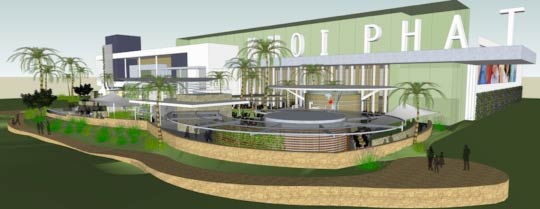
Motorbikes prevail
The basement garage is no ordinary garage. In Vietnam, the vast majority of people travel by motorbike, not by car. Only the very rich own cars due to an import duty that is twice the cost of the base car, making a car three times as expensive in Vietnam as in the U.S. So the garage has parking for 830 motorbikes and only 53 cars. Yes, 94% of the parking is for
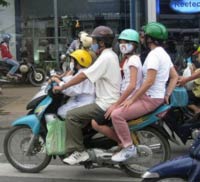 motorbikes. And motorbikes are not limited to one person per bike. An entire family of two adults and two children can often be seen riding a single motorbike. So we estimate the garage will have parking for over 2,000 customers.
motorbikes. And motorbikes are not limited to one person per bike. An entire family of two adults and two children can often be seen riding a single motorbike. So we estimate the garage will have parking for over 2,000 customers.
A very interesting feature of the garage is the type of security system it will have for motorbikes, something you won’t find in the West. There is a small charge to park your motorbike, around 15 cents US. When a motorbike enters the garage, they stop at the security check-in, pay and a computer-camera system records both the driver’s face and the license plate. Then when they leave, the driver passes through a security checkpoint to make sure the original driver is on the motorbike by matching the license to the photo of their face.
We had to change our entire design mindset about the layout of the FEC, as the vast majority of customers will be entering internally into the ground floor of the building via the lifts and stair from the garage’s lobby, not through the ground floor front door. And that brought up an issue. How wide do the stairs have to be to handle the number of people that will be entering and leaving the garage at peak times? We had to turn to design standards for subways at rush hour to find the answer. The stairs will handle over 4,000 people per hour.
Using the metric system
The U.S., U.K. and parts of the U.K’s former empire still use imperial measurement (pounds, feet-inches, acres, etc.). The rest of the world uses the metric system. So in Vietnam our design documents are in metric measurements. We are used to working in metric based on our previous international work. However, Khoi Phat FEC presented us with a new challenge. Instead of measurements expressed in meters or centimeters as they are in most of the metric world, they all have to be in millimeters. So a distance of 100 feet is not 30.48 meters or 3,048 centimeters; it’s 30,480 millimeters. Longer distances are in numbers in the 100s of thousands. This takes some adjustment to get used to for dimensioning and reading plans. We think this may be due to the Vietnamese money, the Dong. Currently 1 US dollar equals approximately 20,800 Dongs (1 Euro = 27,500 Dongs), so the Vietnamese are used to dealing with large numbers, numbers with two or three more zeros than we are accustomed to.
An outdoor culture
Da Nang is a very outdoor-oriented culture. The weather never gets extremely hot or very cold. Over the course of a year, the temperature typically varies from 66°F to 95°F and is rarely below 63°F or above 98°F. Da Nang residents love to dine outdoors. Almost all restaurant dining is open-air and much is outdoors. In the West, the last place you would want to dine outdoors is along a busy street. Not so in Da Nang, that is the preferred place to sit.
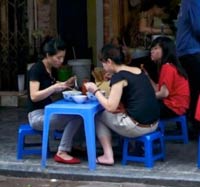 There appear to be two reasons for this street-side dining culture. One, and perhaps the most important, is that the streets aren’t filled with fast moving automobiles with their noise and exhausts. It’s filled with motorbikes going at a much lower speed. So watching the motorbikes scoot by is much more like people watching than watching Western traffic where you can’t really see the people in the cars. The other factor is the many street food vendors, all setting up shop on the street-side sidewalks. Street food dining was a part of the culture long before the increased popularity and growth of restaurants.
There appear to be two reasons for this street-side dining culture. One, and perhaps the most important, is that the streets aren’t filled with fast moving automobiles with their noise and exhausts. It’s filled with motorbikes going at a much lower speed. So watching the motorbikes scoot by is much more like people watching than watching Western traffic where you can’t really see the people in the cars. The other factor is the many street food vendors, all setting up shop on the street-side sidewalks. Street food dining was a part of the culture long before the increased popularity and growth of restaurants.
Karaoke
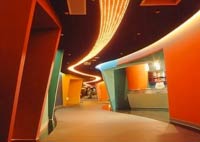 Karaoke centers in Vietnam can be quite elaborate
Karaoke centers in Vietnam can be quite elaborateWhen Randy White, our CEO, first visited Da Nang for cultural research, our client explained that young adults in Vietnam love karaoke. So Randy had our client take him to some karaoke parties to learn about it. We had heard about karaoke in Asia, but never really understood how it worked. In Da Nang, private karaoke rooms basically take the place of bars where young adults will gather. It is the major form of out-of-home entertainment for young adults. A group of friends, usually eight or more, will rent a private karaoke room for several hours where they will drink beer, eat snacks and participate in karaoke. The karaoke machines are quite sophisticated in Vietnam as they rate the quality of the singing. So the friends often break-up into teams and bet on which team will end up with the highest score. There are entire multi-story buildings throughout Da Nang that are dedicated karaoke centers.
As is so often the case with design, one designer will just copy what another has done and not necessarily practice evidence-based design. Often what are referred to as best practices are not really the best, only what has become the standard in the industry. We suspected this might be the case with the design of karaoke centers in Vietnam, so along with our client, we embarked on some serious research about the best designs and practices for karaoke rooms and centers. We conducted an on-line survey of young adults (in Vietnamese) and our client interviewed people and sent representatives to Ho Chi Minh City (formerly named Saigon), the largest city in Vietnam, to visit the best karaoke centers there and talk to the owners.
As we suspected, we learned a lot from the research on how to improve the karaoke center’s and rooms’ designs and the overall karaoke experience. This included serving fresh cooked foods (not just the packaged snacks and fruits other Da Nang karaoke centers offer) how to improve the wait service to the rooms and how to design the rooms with private toilets.
Anthropometrics
If you visit Vietnam, you quickly notice that Vietnamese are smaller than Westerners. This concerned us, as it could affect the appropriate design of many parts of the center. As we have learned from our experience, including prototyping different young children’s play attractions, a difference in height of just one or two inches will effect how children use the play equipment in the children’s edutainment center. If Vietnamese children are shorter, we need to adjust the measurements of the equipment versus what we use in the West. If Vietnamese are shorter, we need to make sure that they can reach the pedals on the go-karts. We don’t want some adults to be restricted from riding the adult go-karts due to their short height and only being able to ride the rookie go-karts that are for children.
Finding current anthropometric data (measurement of the physical size and shape of humans) for Vietnamese proved impossible, so we worked with our client to develop the data. The schools in Vietnam measure the height and weight of students every year. Our client was able to obtain a large sample of that data for different children’s and young adult ages and we found that Vietnamese children were the same as
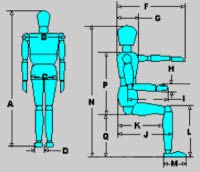 American children in height whereas 20-year-olds were shorter. After digging into academic research on Vietnamese diets, we found the explanation. Over the past decade or so, there has been a significant increase in the amount of protein in the Vietnamese diet, which in turn has lead to children growing taller. Of course the 20-year-olds didn’t have the advantage of the better diet during their earlier years, so their heights did not increase as much. Although we could not obtain data on older adults, our observations indicate they are even shorter than the 20-year-old Vietnamese and Americans. Another factor we took into consideration in our designs is that nutrition in the outlying rural areas, where a lot of Vietnamese tourists will come from, is not as good as the nutrition in the Da Nang metro area, where our school and university data came from, so these customers will be shorter than city residents.
American children in height whereas 20-year-olds were shorter. After digging into academic research on Vietnamese diets, we found the explanation. Over the past decade or so, there has been a significant increase in the amount of protein in the Vietnamese diet, which in turn has lead to children growing taller. Of course the 20-year-olds didn’t have the advantage of the better diet during their earlier years, so their heights did not increase as much. Although we could not obtain data on older adults, our observations indicate they are even shorter than the 20-year-old Vietnamese and Americans. Another factor we took into consideration in our designs is that nutrition in the outlying rural areas, where a lot of Vietnamese tourists will come from, is not as good as the nutrition in the Da Nang metro area, where our school and university data came from, so these customers will be shorter than city residents.
Large and heavy bowling balls
During Randy’s original cultural research, he visited all the entertainment centers in Da Nang and Ho Chi Minh City. There were a number of new small children’s entertainment centers and small bowling centers with ten-pin bowling. Our research found that ten-pin bowling was not very popular. It was easy to understand why. Adult Vietnamese are shorter and smaller than Westerners. Their hands are smaller. Ten-pin bowling balls are very large and heavy. The three finger holes are very awkward to use, especially if you have smaller fingers and not a wide finger reach. Here we had an excellent example of the first Vietnamese bowling centers literally importing a Western entertainment concept that didn’t fit the culture, or should we say, the culture’s people.
 Duckpin bowling balls are much smaller than ten-pin bowling balls and don’t have finger holes
Duckpin bowling balls are much smaller than ten-pin bowling balls and don’t have finger holesWe felt bowling could be very popular, as it had similarities to karaoke:
- A group of friends get together at a commercial entertainment facility (most of their homes are too small to accommodate a group party) to drink and eat.
- They take turns sitting around watching someone perform, or in this case, bowl.
But a cultural modification was needed to make bowling work. The answer was to use duckpin bowling that uses a smaller ball. Duckpin bowling balls are about the size of a large grapefruit that only weighs about 25% of what an adult ten-pin bowling ball weighs and have no finger holes. So we worked with US Bowling Corporation to design bowling lanes with a duckpin pinsetter and ball return. In the VIP bowling room, we will also have karaoke, so customers can sing while they bowl.
Construction culture
Construction technology and techniques vary from one culture to another. Different materials will be used for construction. There are different voltages, types of conduit, foundations, roofing, finish materials, etc. Another thing that varies is availability of lighting fixtures, doors, furniture, finish materials, etc. Whereas marble counters might be an expensive option in one country, they could be the least expensive option in another. Value engineering for the most cost effective design solutions for a project is an important design consideration that has to be carefully researched at the very beginning of the design process.
In the West we are used to making selections from catalogues of pre-manufactured items. That is basically due to high labor costs in the West. It is more economical to mass-produce items in a factory. In other parts of the world, including Vietnam, labor is far less expensive, so rather than pre-manufacture many items, things are custom made. As an example, we inquired what the stand door size was in Vietnam. In the West door frames and sizes are very standardized. There is no such thing as a standard in Vietnam, as doorframes and doors are custom built for each project. If you want furniture, you specify the design, measurements and materials you want, and it is custom made, at far less cost than if you imported it from the West.

Coffee cafes in Vietnam are different than the typical Western ‘Starbucks’ model. The Khoi Phat FEC coffee café will include a bakery. Most of the seating is outdoors on multi-levels in keeping with Da Nang’s outdoor dining culture.
Working without catalogues from which to select many building materials and finishes takes adjustment. It opens the door many times to more creative designs, as you are not limited by catalogue options or high labor costs to have things custom made.
Another thing our company does on international projects is work with local MEP (mechanical, electrical, plumbing), structural and civil engineers, as they understand the local design and construction culture. In places like Vietnam this can present challenges due to language differences. Although the engineers we are working with in Vietnam all speak English, their fluency varies and written email communication can sometimes be a challenge. The other issue is that the English language varies throughout the world, so what one English word means in one part of the world can have a different meaning in another part of the word. And terms vary. It’s an elevator in America and lift in other countries. There are even words that don’t exist in American English that exist elsewhere as well as American words that don’t exist elsewhere. What this means is that written and spoken English does not assure 100% communication. We find that we need to have more face-to-face meetings with the local engineers than we might in the West to assure clear communication. This of course often means some serious travel. It’s 20 hours of in-the-air flight time for us to travel from our Kansas City, Missouri office to Da Nang.
Designing and producing entertainment projects for our clients in different cultures of the world has its challenges and requires careful research, but it is very rewarding when the result is a culturally-correct business that has long-term financial success.
For more about this, see:
- Beware of Western Conquistadores
- The importance of cultural competence to location-based leisure projects
- Culture varies across countries and cultures
To learn more about Da Nang, Vietnam, check out this recent USA Today article
For more about duckpin bowling, see It’s time to reinvent the game of bowling
* Culturally-correct means that you can’t just literally export a typical Western model and expect it to be successful. International projects need to be culturally appropriate to succeed.
Vol. XIII, No. 1, January 2013
- Editor's corner
- The challenges of producing international entertainment projects: Our Vietnam experience
- The science of the queue
- Foundations Entertainment University goes to Vegas
- Feasibility and economics for entertainment projects in emerging economies
- Birthday University scholarships
- Location-based entertainment experiences go premium
- Entertainment spending in the local community by income


 Click to enlarge
Click to enlarge